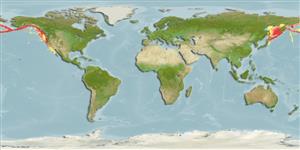| Native range | Year 2100 |

|
| Anoplopoma fimbria AquaMaps Data sources: GBIF OBIS |
Length at first maturity
Lm 60.5, range 58 - 62 cm
Human uses
Fisheries: highly commercial; aquaculture: likely future use; aquarium: public aquariums
Phylogenetic diversity index
(Ref. 82805)
PD50 = 1.2500 many relatives (e.g. carps) 0.5 - 2.0 few relatives (e.g. lungfishes)
Trophic Level
(Ref. 69278)
3.8 ±0.2 se; Based on diet studies.
Resilience
(Ref. 69278)
Very Low, minimum population doubling time more than 14 years (K=0.2; tm=6; Fec=100,000; tmax=94)